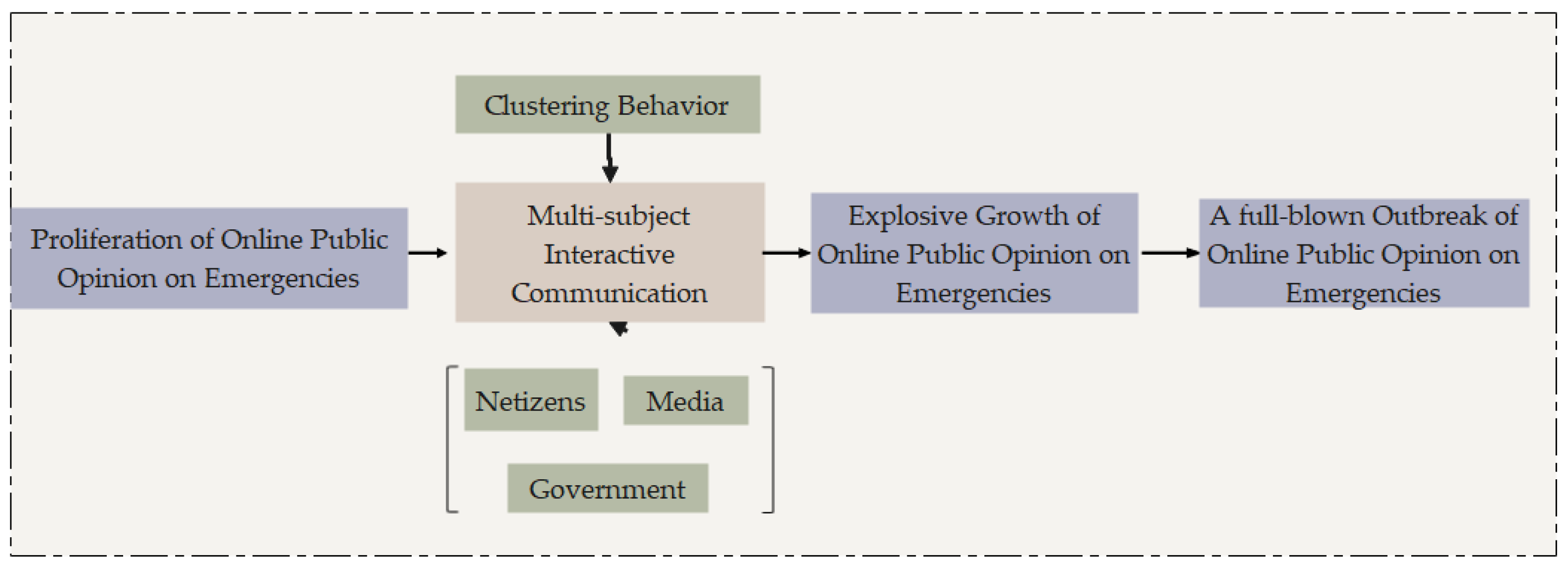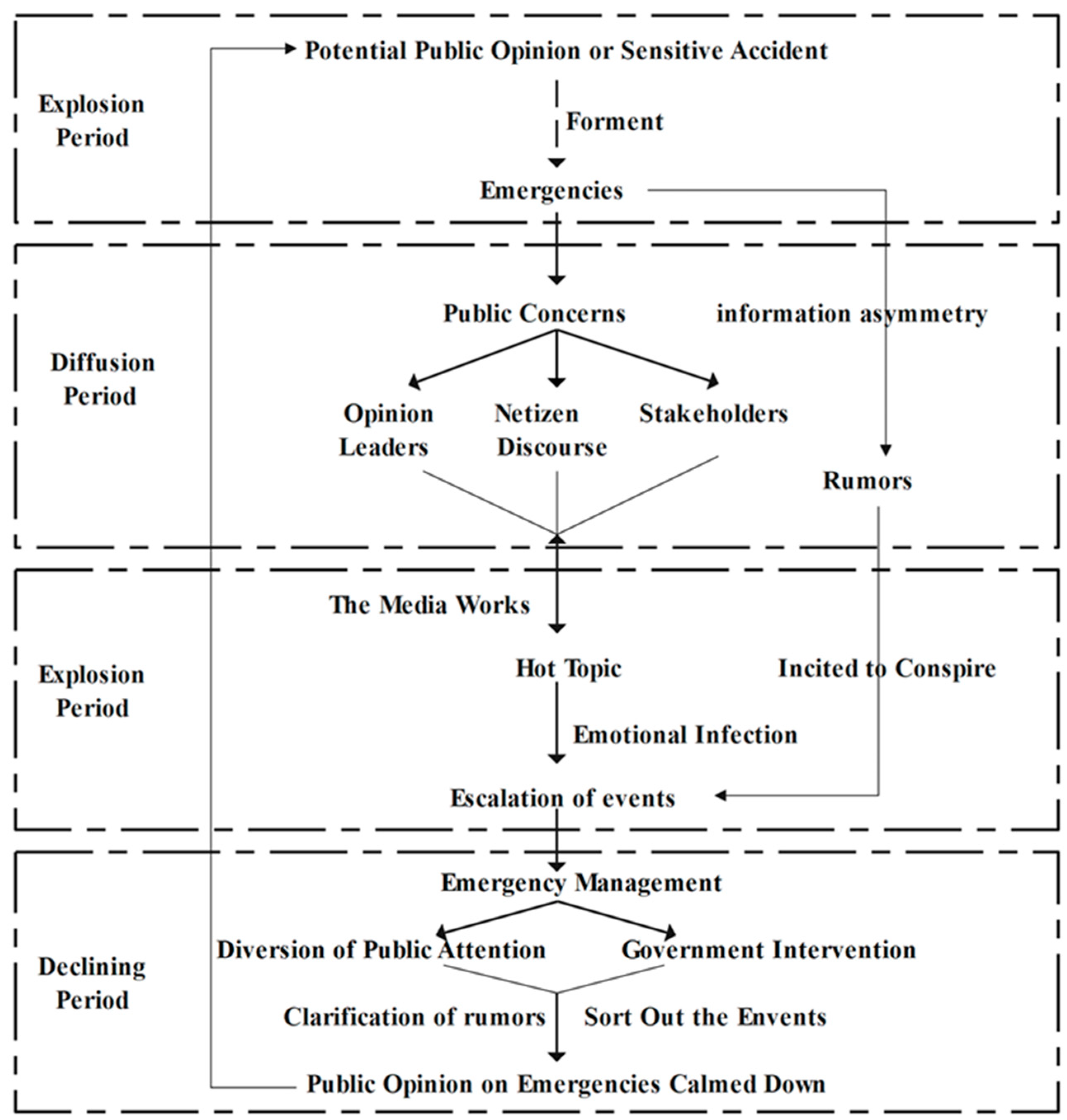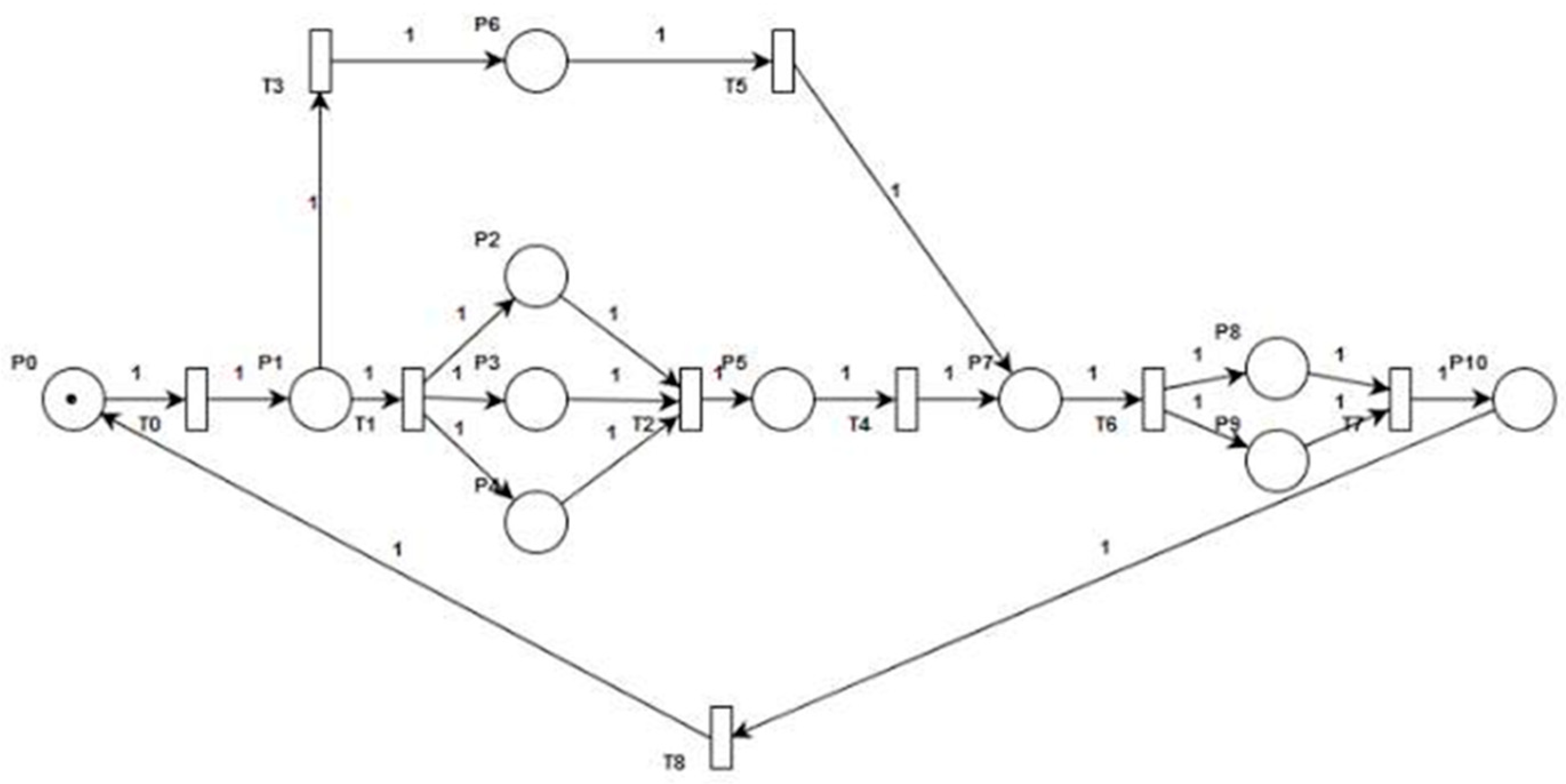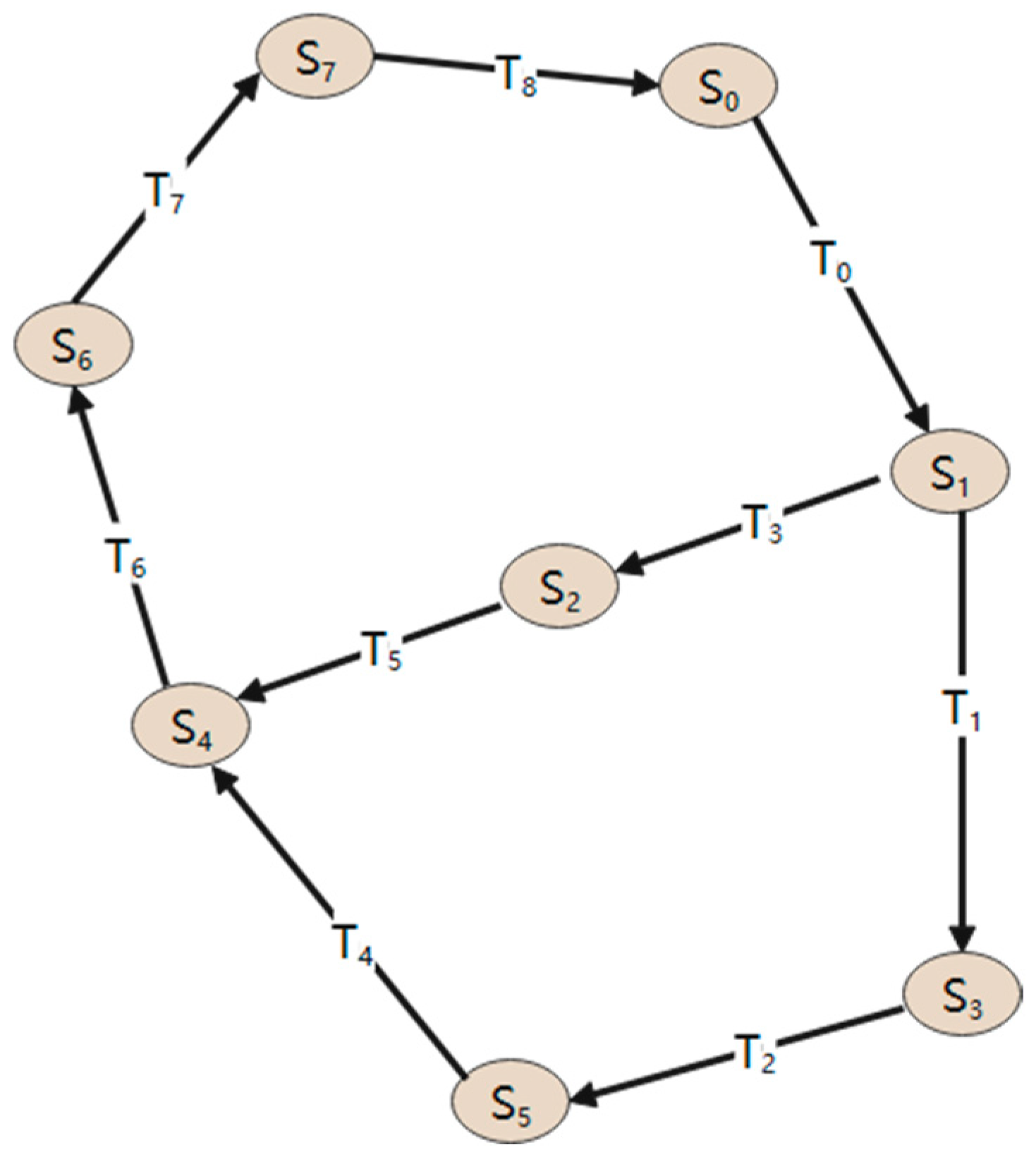A New Stochastic Petri Net Modeling Approach for the Evolution of Online Public Opinion on Emergencies: Based on Four Real-Life Cases
Abstract
1. Introduction
2. Literature Review
2.1. Public Opinion on Emergencies
2.1.1. Influencing Factors of Public Opinion on Emergencies
2.1.2. The Stages of Evolution of Public Opinion on Emergencies
2.1.3. Modeling of Public Opinion on Emergencies
2.1.4. Empirical Evidence for Critical Incident Cases
2.2. Summary
3. Methods and Design
3.1. Stages in the Evolution of Public Opinion
3.1.1. Formation Period
3.1.2. Diffusion Period
3.1.3. Explosion Period
3.1.4. Declining Period
3.2. Modeling
3.2.1. Model Design
- (1)
- Places: These are the state tokens of a Petri net, usually represented by circles. Places can contain any number of tokens to indicate the system’s state.
- (2)
- Transitions: Events representing changes in the system’s state are usually presented as rectangles or bars. When a transition occurs, the markers in the positions connected to it change according to specific rules.
- (3)
- Tokens: These are entities placed at different locations to indicate some resource or state of the system. The distribution of tokens defines the current state of the Petri net.
- (4)
- Input Arcs: These are arrows pointing from a location to a change, indicating the conditions or resources required for the change to occur.
- (5)
- Output Arcs: These are arrows pointing from a change that occurs to a location, indicating the results or resources generated after the change.
- (6)
- Weights: These are labeled on the arcs to indicate the number of markers moving from position to variation or vice versa. Weights in simple Petri nets are usually 1, but weights can represent more complex relationships in more complicated models.
- (1)
- State table: describes the possible states defined in the Stochastic Petri Net model.
- (2)
- Transition matrix: represents the possible transitions between states. For any state sequence, a Markov chain is used to calculate the probability of each state. In a Stochastic Petri Net model, state transitions occur with a deterministic probability. By transforming the Stochastic Petri Net model into a Markov chain, we can obtain a probability model that guides the system’s state transition.
3.2.2. Constructing the SPN Model
3.2.3. SPN Model Isomorphic to a Markov Chain
3.3. Indicator Selection and Calculation Methodology
4. Case Studies
- (1)
- Public Health Event: The arrival of a person released from a prison in Wuhan with a confirmed diagnosis of new coronavirus to Beijing;
- (2)
- Natural Disasters: The Henan Zhengzhou 7.20 rainstorm;
- (3)
- Accidental Catastrophes: Guangdong Province, MeiDai Expressway, Tai Po section of the collapse;
- (4)
- Social Security Incidents: CCTV exposure of the “bad meat” incident in “Braised Pork with Preserved Vegetable in Soya Sauce”.
4.1. Overview of Cases
4.2. Model Parameterization
4.3. Analyzing Results
4.3.1. Evolutionary Leaps
4.3.2. Complexity
4.3.3. Key Nodes
4.3.4. Evolutionary Efficiency
4.3.5. Length of Implementation
4.4. Discussion
5. Conclusions
- (1)
- The study findings show that the model has certain advantages in analyzing the evolution of public opinion on emergencies based on multi-factor coupling and quantifying the key nodes involved in this process.
- (2)
- The analysis of the evolution model revealed different evolutionary leap mechanisms of online public opinion regarding different types of emergencies. Their complexity, key nodes, evolution rate, and execution time were also different. The change law of the equilibrium state and its development path were analyzed with four case studies using the scenario simulation method, and the results indicate that the proposed model can more effectively address the challenges posed by the formation of online public opinion on emergencies.
Author Contributions
Funding
Data Availability Statement
Conflicts of Interest
References
- Lin, Y.; Xie, X.; Zhang, D. Analysis of online public opinion evolution under the influence of complex interaction behaviors. Chin. J. Manag. Sci. 2020, 28, 212–221. [Google Scholar]
- Guan, X.; Zhang, Z.; Zhang, S. Evolution Mechanism of The Ecological Dissemination System of Internet Public Opinion. In LISS 2014: Proceedings of 4th International Conference on Logistics, Informatics and Service Science; Springer: Berlin/Heidelberg, Germany, 2015. [Google Scholar]
- Wang, N.; Lv, X.L. Research on emotional analysis of netizens and topic distribution under public health emergencies: —A Case Study of COVID-19. In Proceedings of the 2020 International Conference on Public Health and Data Science (ICPHDS), Guangzhou, China, 20–22 November 2020. [Google Scholar] [CrossRef]
- Fang, S.; Zhao, N.; Chen, N.; Xiong, F.; Yi, Y. Analyzing and Predicting Network Public Opinion Evolution Based on Group Persuasion Force of Populism. Phys. A Stat. Mech. Its Appl. 2019, 525, 809–824. [Google Scholar] [CrossRef]
- Liu, Y.; Liu, R.; Li, R. Public Opinion Guidance and Science and Technology Dissemination for Public Health Emergencies. Disaster Manag. 2013, 133, 303–309. [Google Scholar] [CrossRef][Green Version]
- Yao, C.; He, G. Key Nodes Analysis of Microblogging Public Opinion Spread About Public Emergencies-Such As The Missed Malaysia Flight MH370. In Proceedings of the 2015 International Conference on Modeling, Simulation and Applied Mathematics, Phuket, Thailand, 23–24 August 2015. [Google Scholar] [CrossRef]
- Yang, F.; Sun, T. Who has set whose agenda on social media? A dynamic social network analysis of Tweets on Paris attack. Commun. Q. 2021, 69, 341–363. [Google Scholar] [CrossRef]
- Lim, S.; Berry, F.S.; Lee, K.-H. Stakeholders in the same bed with different dreams: Semantic network analysis of issue interpretation in risk policy related to mad cow disease. J. Public Adm. Res. Theory 2016, 26, 79–93. [Google Scholar] [CrossRef]
- Levitan, K.B. Information resources as “Goods” in the life cycle of information production. J. Am. Soc. Inf. Sci. 1982, 33, 44–54. [Google Scholar] [CrossRef]
- Li, S.; Liu, Z.; Li, Y. Temporal and spatial evolution of online public sentiment on emergencies. Inf. Process. Manag. 2020, 57, 102177. [Google Scholar] [CrossRef] [PubMed]
- Zhang, Y.; Chen, N.; Du, W.; Yao, S.; Zheng, X. A New Geo-Propagation Model of Event Evolution Chain Based on Public Opinion and Epidemic Coupling. Int. J. Environ. Res. Public Health 2020, 17, 9235. [Google Scholar] [CrossRef]
- Li, Y.; Shen, X. Spread of Online Public Opinion of Animal Epidemic Emergency: A Case Study of the H7N9 Incident Based on Healthcare Data Analytics. J. Healthc. Eng. 2021, 2021, 1512742. [Google Scholar] [CrossRef]
- Zhang, J.; Chen, Y.; Zhao, Y.; Wolfram, D.; Ma, F. Public health and social media: A study of Zika virus-related posts on Yahoo! Answers. J. Assoc. Inf. Sci. Technol. 2020, 71, 282–299. [Google Scholar] [CrossRef]
- Chen, J.; Du, S.; Yang, S. Mining and Evolution Analysis of Network Public Opinion Concerns of Stakeholders in Hot Social Events. Mathematics 2022, 10, 2145. [Google Scholar] [CrossRef]
- Burkholder, B.T.; Toole, M.J. Evolution of complex disasters. Lancet 1995, 346, 1012–1015. [Google Scholar] [CrossRef]
- Liu, Y.; Zhu, J.; Shao, X.; Adusumilli, N.C.; Wang, F. Diffusion patterns in disaster-induced internet public opinion: Based on a Sina Weibo online discussion about the ‘Liangshan fire’ in China. Environ. Hazards 2020, 20, 163–187. [Google Scholar] [CrossRef]
- Qiu, Q.; He, J.; Chen, H.; Qiu, J. Research on The Evolution Law of Emergency Network Public Opinion. In Proceedings of the 2019 12th International Symposium on Computational Intelligence and Design (ISCID), Zhejiang, China, 1 December 2019. [Google Scholar] [CrossRef]
- He, M.; Zhang, D.; Wang, H.; Li, X.; Fang, P. Public Opinion Evolution Model with The Variable Topology Structure Based on Scale Free Network. Acta Phys. Sin. 2010, 59, 5175–5181. [Google Scholar]
- Pohl, D.; Bouchachia, A.; Hellwagner, H. Social media for crisis management: Clustering approaches for sub-event detection. Multimed. Tools Appl. 2015, 74, 3901–3932. [Google Scholar] [CrossRef][Green Version]
- Lan, Y.; Dong, X.; Zeng, R.; Qi, Z. Research on effects model of derived of network public opinion from the perspective of information alienation. J. Intell. 2015, 34, 139–143. [Google Scholar]
- Zhang, Y.; Feng, Y. Two-layer coupled network model for topic derivation in public opinion propagation. China Commun. 2020, 17, 176–187. [Google Scholar] [CrossRef]
- Zhou, D.; Shi, L.; Wang, B.; Xu, H.; Huang, W. Are Your Comments Positive? A Self-Distillation Contrastive Learning Method for Analyzing Online Public Opinion. Electronics 2024, 13, 2509. [Google Scholar] [CrossRef]
- Lai, J.; Yang, X.; Luo, W.; Zhou, L.; Li, L.; Wang, Y.; Shi, X. RumorLLM: A Rumor Large Language Model-Based Fake-News-Detection Data-Augmentation Approach. Appl. Sci. 2024, 14, 3532. [Google Scholar] [CrossRef]
- Cheng, Q.; Zhang, Y.; Li, Y. Topic Relevance of Public Health Emergencies Influence Internet Public Opinion Resonance: Simulation Based on Langevin’s Equation. Math. Probl. Eng. 2021, 2021, 5818346. [Google Scholar] [CrossRef]
- Yang, K.; Miao, R. Research on Evolution Model and Crisis Prevention and Control of New Media Public Opinion. In Proceedings of the 2017 International Conference on Education Innovation and Social Science (ICEISS 2017), Jinan, China, 19 November 2017. [Google Scholar]
- Wang, L.; Wang, K.; Wu, J. Public Opinion Propagation and Evolution of Public Health Emergencies in Social Media Era: A Case Study of 2018 Vaccine Event. Data Anal. Knowl. Discov. 2019, 3, 42–52. [Google Scholar]
- Lian, S.; Li, Z. Public opinion guidance and communication mechanism innovation of public health events based on the multitask learning network in the internet era. Mob. Inf. Syst. 2022, 2022 Pt 4, 7106054.1–7106054.8. [Google Scholar] [CrossRef]
- Li, W.; Zeng, F.; Zhou, W.; Chen, Z. Internet public opinion diffusion mechanism in public health emergencies: Based on entropy flow analysis and dissipative structure determination. Front. Public Health 2021, 9, 731080. [Google Scholar] [CrossRef] [PubMed]
- Zhang, Y.; Xie, Y.; Shi, V.; Yin, K. Dynamic Characteristics and Evolution analyses of Information Dissemination Theme of Social Networks under Emergencies. Behav. Sci. 2023, 13, 282. [Google Scholar] [CrossRef]
- Cui, P.; He, Y. Research on The Dissemination and Response of Network Public Opinion of Emergency Events in Colleges Based on Crowd Intelligence Thinking. Open J. Soc. Sci. 2019, 7, 281. [Google Scholar] [CrossRef]
- Ye, P.; Liu, L. Factors Influencing College Students’ Behaviors of Spreading Internet Public Opinions on Emergencies in Universities. Inf. Discov. Deliv. 2021, 50, 75–86. [Google Scholar] [CrossRef]
- Tan, K.; Xie, L.; Lin, L. Research on The Evolution Path of Public Opinion in Environmental Emergencies. E3S Web Conf. 2021, 257, 03059. [Google Scholar] [CrossRef]
- Zhang, L.; Wei, J.; Boncella, R.J. Emotional communication analysis of emergency microblog based on the evolution life cycle of public opinion. Inf. Discov. Deliv. 2020, 48, 151–163. [Google Scholar] [CrossRef]
- Medina-Garcia, S.; Medina-Marin, J.; Montaño-Arango, O.; Gonzalez-Hernandez, M.; Hernandez-Gress, E.S. A Petri Net Approach for Business Process Modeling and Simulation. Appl. Sci. 2023, 13, 11192. [Google Scholar] [CrossRef]
- Zhu, H.; Liu, G.; Yu, Z.; Li, Z. Detectability in Discrete Event Systems Using Unbounded Petri Nets. Mathematics 2023, 11, 3862. [Google Scholar] [CrossRef]
- Saadaoui, I.; Labed, A.; Li, Z.; El-Sherbeeny, A.M.; Du, H. Language-Based Opacity Verification in Partially Observed Petri Nets through Linear Constraints. Mathematics 2023, 11, 3880. [Google Scholar] [CrossRef]
- Ma, D.; Zhang, C.; Zhao, L.; Huang, Q.; Liu, B. An analysis of the Evolution of Public Sentiment and Spatio-Temporal Dynamics Regarding Building Collapse Accidents Based on Sina Weibo Data. ISPRS Int. J. Geo-Inf. 2023, 12, 388. [Google Scholar] [CrossRef]
- Yang, S.; Liu, S.; Su, K.; Chen, J. A Rumor Propagation Model Considering Media Effect and Suspicion Mechanism under Public Emergencies. Mathematics 2024, 12, 1906. [Google Scholar] [CrossRef]
- Li, W.; Shen, H.; Huang, Z.; Yang, H. Research on the Dynamical Behavior of Public Opinion Triggered by Rumor Based on a Nonlinear Oscillator Model. Entropy 2023, 25, 1614. [Google Scholar] [CrossRef]
- Lu, Y. The Influence of Cognitive and Emotional Factors on Social Media Users’ Information-Sharing Behaviors during Crises: The Moderating Role of the Construal Level and the Mediating Role of the Emotional Response. Behav. Sci. 2024, 14, 495. [Google Scholar] [CrossRef]
- Gomes, L.; Natário, D.; Costa, A.; Barros, J.-P.; Campos-Rebelo, R. Event-Based Modeling of Input Signal Behaviors for Discrete-Event Controllers. Appl. Sci. 2024, 14, 5289. [Google Scholar] [CrossRef]
- Zuberek, W.M. Performance evaluation using unbound timed Petri nets. In Proceedings of the 3rd International Workshop on Petri Nets and Performance Models, Kyoto, Japan, 11–13 December 1989; pp. 180–186.
- Molly, M.K. Discrete Time Stochastic. IEEE Trans. Softw. Eng. 1985, 31, 417–423. [Google Scholar] [CrossRef]









| Elements of Public Opinion | Scope of the Impact Relationship | Change T | Meaning of Change |
|---|---|---|---|
| P0 | Sensitive incidents occur | T0 | Festering events |
| P1 | Contingency | T1 | Leading netizens’ attention |
| P2 | Opinion leader | T2 | The media works |
| P3 | Netizen’s comments | T3 | Lack of transparency of information |
| P4 | Stakeholder | T4 | Emotional contagion |
| P5 | Hot topic | T5 | Rumor mongering |
| P6 | Rumors | T6 | Emergency management |
| P7 | Escalation of events | T7 | Solving problems and clarifying rumors |
| P8 | Government intervention | T8 | Deal with the aftermath (arising from an accident) |
| P9 | Diversion of public attention | ||
| P10 | Die down |
| T0 | T1 | T2 | T3 | T4 | T5 | T6 | T7 | T8 | |
|---|---|---|---|---|---|---|---|---|---|
| P0 | −1 | 0 | 0 | 0 | 0 | 0 | 0 | 0 | 1 |
| P1 | 1 | −1 | 0 | 0 | 0 | 0 | 0 | 0 | 0 |
| P2 | 0 | 1 | −1 | 0 | 0 | 0 | 0 | 0 | 0 |
| P3 | 0 | 1 | −1 | 0 | 0 | 0 | 0 | 0 | 0 |
| P4 | 0 | 1 | −1 | 0 | 0 | 0 | 0 | 0 | 0 |
| P5 | 0 | 0 | 1 | −1 | −1 | 0 | 0 | 0 | 0 |
| P6 | 0 | 0 | 0 | 1 | 0 | −1 | 0 | 0 | 0 |
| P7 | 0 | 0 | 0 | 0 | 1 | 1 | −1 | 0 | 0 |
| P8 | 0 | 0 | 0 | 0 | 0 | 0 | 1 | −1 | 0 |
| P9 | 0 | 0 | 0 | 0 | 0 | 0 | 1 | −1 | 0 |
| P10 | 0 | 0 | 0 | 0 | 0 | 0 | 0 | 1 | −1 |
| Event | Event Description |
|---|---|
| The arrival of a person released from prison in Wuhan with a confirmed diagnosis of new coronary pneumonia to Beijing | On 26 February 2020, Beijing Dongcheng District WeChat public reported a confirmed case of new coronavirus infection of pneumonia (case 24); media reports indicated that Ms. H was an ex-prisoner in Wuhan who had been advised by family members to drive to Beijing. In the most critical epidemic prevention and control period, This incident violates the traffic control measures in Wuhan and Ezhou, triggering many netizens to discuss the incident. On 27 February, Bai Yansong discussed the event through microblog and Tiktok, stimulated continuous discussion among interested netizens, and the attention continued to increase, leading to the formation of public opinion amid fermentation. On 2 March, a case was filed to investigate whether this constituted a violation of the law. It announced the results of the investigation on the same day. On 16 March, the individual was discharged from the hospital, and on 22 March, police informed this case of a woman who was released from jail and arrived from Wuhan to Beijing. |
| Henan Zhengzhou 7.20 rainstorm | From 17 to 23 July 2021, Henan Province was hit by historically rare hefty rainfall and severe flooding. On 20 July, in particular, Zhengzhou City suffered significant casualties and property damage. The most popular follow-up events that netizens were concerned about included the K226 train requesting emergency support, the flooding of Changzhuang Reservoir, Zhengzhou Metro Line 5, a compartment with many people trapped inside, and the number of people trapped and casualties due to the disaster. |
| Collapse of the Tai Po section of the Meidai Expressway in Guangdong Province | At around 2:10 a.m. on 1 May 2024, a severe road collapse accident occurred on the Chaoyang section of the Meidai Expressway in Meizhou City, Guangdong Province. The accident caused several vehicles to become trapped, catch fire, and explode. According to reports, the accident resulted in at least 48 deaths and 30 injuries. After the accident, the government quickly organized rescue efforts and set up an on-site command, with about 500 people from public security, emergency response, firefighting, health and hygiene, transport, mine rescue teams, and other departments participating in the on-site rescue. |
| CCTV exposure of the “bad meat” incident in “Braised Pork with Preserved Vegetable in Soya Sauce” | On 15 March 2024, the CCTV 3–15 Evening Party reported that, as a central area for the production of plum and vegetable button-prepared products, some local enterprises in Fuyang City, Anhui Province, used trough-head meat, which had not been strictly treated, to make plum and vegetable button-prepared products. Trough-head meat, also known as lymphatic meat in daily life, is a part of pork recognized as being of poor quality and low in price. |
| Vicissitudes | Average Implementation Rate | |||
|---|---|---|---|---|
| Event 1 | Event 2 | Event 3 | Event 4 | |
| 0.5 | 0.5 | 0.175 | 0.125 | |
| 0.5 | 0.2 | 0.5 | 0.33 | |
| 0.333 | 0.2 | 0.2 | 0.175 | |
| 0.25 | 0.25 | 0.33 | 0.2 | |
| 1 | 0.167 | 0.33 | 0.167 | |
| 0.2 | 0.25 | 0.175 | 0.25 | |
| 0.333 | 0.5 | 0.2 | 0.2 | |
| 0.5 | 0.33 | 0.2 | 0.25 | |
| 0.175 | 0.25 | 0.5 | 0.2 | |
| Event | Pace of Development | Span | Event Description |
|---|---|---|---|
| Event 1 | The rapid pace of development | short duration | Public opinion erupts and peaks rapidly but is quickly controlled due to effective management or other factors. |
| Event 2 | The rapid pace of development | long duration | Public opinion erupts quickly and stays at its peak for longer, possibly because of the issue’s complexity, mismanagement, or continued media attention. |
| Event 3 | The slow pace of development | short duration | Public opinion develops slowly but quickly resolves due to effective intervention or other factors. |
| Event 4 | The slow pace of development | long duration | Public opinion develops gradually and lasts for an extended period, fading slowly without adequate attention or effective measures to address it. |
| Event | Marking Status | |||||||
|---|---|---|---|---|---|---|---|---|
| M0 | M1 | M2 | M3 | M4 | M5 | M6 | M7 | |
| Event 1 | 0.1085 | 0.0681 | 0.0746 | 0.0908 | 0.1806 | 0.0263 | 0.1187 | 0.3263 |
| Event 2 | 0.1039 | 0.1067 | 0.0894 | 0.0894 | 0.1249 | 0.0822 | 0.1803 | 0.2231 |
| Event 3 | 0.2181 | 0.0454 | 0.0805 | 0.1118 | 0.2015 | 0.0672 | 0.1978 | 0.0776 |
| Event 4 | 0.2499 | 0.0599 | 0.0441 | 0.1183 | 0.1254 | 0.1233 | 0.1247 | 0.1543 |
| Event 1 | 0.1085 | 0.0681 | 0.3263 | 0.0908 | 0.0908 | 0.0908 | 0.0263 | 0.0746 | 0.1806 | 0.1187 | 0.1187 |
| Event 2 | 0.1039 | 0.1067 | 0.2231 | 0.0894 | 0.0894 | 0.0894 | 0.0822 | 0.0894 | 0.1249 | 0.1803 | 0.1803 |
| Event 3 | 0.2181 | 0.0454 | 0.0776 | 0.1118 | 0.1118 | 0.1118 | 0.0672 | 0.0805 | 0.2015 | 0.1978 | 0.1978 |
| Event 4 | 0.2499 | 0.0599 | 0.1543 | 0.1183 | 0.1183 | 0.1183 | 0.1233 | 0.0441 | 0.1254 | 0.1247 | 0.1247 |
| Event 1 | 0.1085 | 0.0681 | 0.0908 | 0.0681 | 0.0263 | 0.0746 | 0.1806 | 0.1187 | 0.3263 |
| Event 2 | 0.1039 | 0.1067 | 0.0894 | 0.1067 | 0.0822 | 0.0894 | 0.1249 | 0.1803 | 0.2231 |
| Event 3 | 0.2181 | 0.0454 | 0.1118 | 0.0454 | 0.0672 | 0.0805 | 0.2015 | 0.1978 | 0.0776 |
| Event 4 | 0.2499 | 0.0599 | 0.1183 | 0.0599 | 0.1233 | 0.0441 | 0.1254 | 0.1247 | 0.1543 |
| Event 1 | Event 2 | Event 3 | Event 4 | |
|---|---|---|---|---|
| Average system implementation time/day | 21.836 | 24.137 | 31.497 | 35.848 |
| Event | Evolutionary Leap | Complexity Level | Key Node | Evolutionary Efficiency | Execution Time |
|---|---|---|---|---|---|
| Event 1 | Netizens’ emotional dissemination is more pronounced; incidents are resolved, and rumors are clarified quickly | Rapid escalation of the incident, timely media release, effective government intervention, timely control of public opinion, and calming of the incident | Address the aftermath (arising from an accident) | Fast turnaround rate from rumor-mongering to escalation, efficient emergency response, and public distraction | Public opinion has the shortest execution time and is effectively identified and handled |
| Event 2 | The incident caused continuous public concern and emotional reaction, and public opinion was effectively managed until the issue was entirely resolved | Slow escalation of incidents and continuing problems | Addressing critical incidents per se | Remainders of long-lasting public concern; efficient in clarifying rumors and resolving issues | The incident triggering the formation of public opinion is relatively short; however, it is not fully resolved, and therefore, public opinion continues to be of concern |
| Event 3 | The impact of rumors and hot topics was not evident, but the incident was ultimately addressed and resolved effectively | Frequent sensitive incidents, slow development of public opinion, and eventual effective resolution | Controlling the fermentation of public opinion | Average efficiency in emergency response and public distraction | The slow pace of development, reasonably controlled timing, evidence of adequate public opinion management |
| Event 4 | Sensitive incidents continue to receive attention but lack sufficient measures to address them | Incidents continue to receive attention, and public opinion continues to develop slowly | Control of sensitive incidents | Slow and balanced | Slow onset and evolution, long duration |
Disclaimer/Publisher’s Note: The statements, opinions and data contained in all publications are solely those of the individual author(s) and contributor(s) and not of MDPI and/or the editor(s). MDPI and/or the editor(s) disclaim responsibility for any injury to people or property resulting from any ideas, methods, instructions or products referred to in the content. |
© 2024 by the authors. Licensee MDPI, Basel, Switzerland. This article is an open access article distributed under the terms and conditions of the Creative Commons Attribution (CC BY) license (https://creativecommons.org/licenses/by/4.0/).
Share and Cite
Guo, C.; Song, Y. A New Stochastic Petri Net Modeling Approach for the Evolution of Online Public Opinion on Emergencies: Based on Four Real-Life Cases. Systems 2024, 12, 333. https://doi.org/10.3390/systems12090333
Guo C, Song Y. A New Stochastic Petri Net Modeling Approach for the Evolution of Online Public Opinion on Emergencies: Based on Four Real-Life Cases. Systems. 2024; 12(9):333. https://doi.org/10.3390/systems12090333
Chicago/Turabian StyleGuo, Chen, and Yinghua Song. 2024. "A New Stochastic Petri Net Modeling Approach for the Evolution of Online Public Opinion on Emergencies: Based on Four Real-Life Cases" Systems 12, no. 9: 333. https://doi.org/10.3390/systems12090333
APA StyleGuo, C., & Song, Y. (2024). A New Stochastic Petri Net Modeling Approach for the Evolution of Online Public Opinion on Emergencies: Based on Four Real-Life Cases. Systems, 12(9), 333. https://doi.org/10.3390/systems12090333











